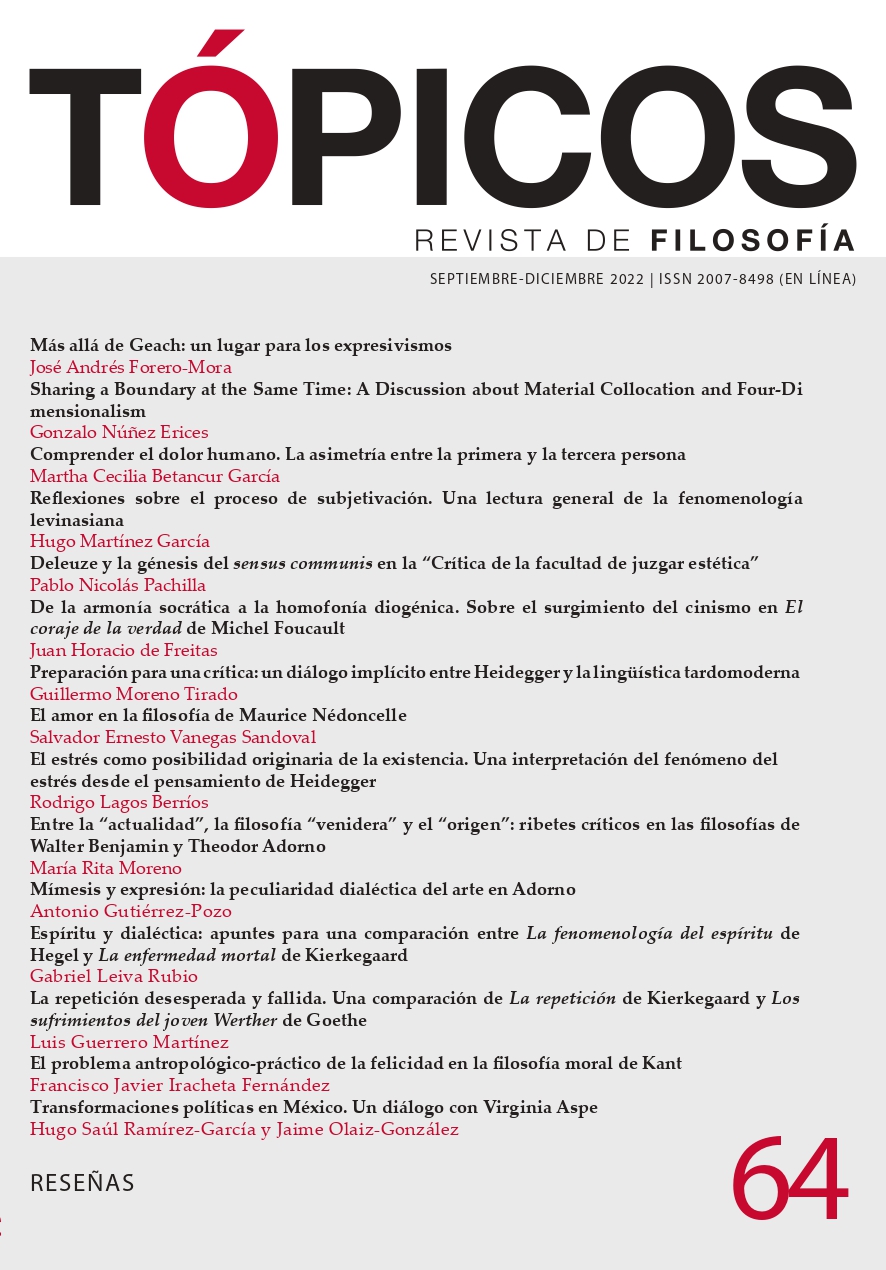Understanding Human Pain. The Asymmetry Between the First and the Third Person
Publiée 2022-08-13
Mots-clés
- asimetría entre primera y tercera persona,
- expresiones de dolor,
- postura egocéntrica,
- observación interpretante,
- comprensión
(c) Copyright Tópicos, Revista de Filosofía 2022

Ce travail est disponible sous licence Creative Commons Attribution - Pas d'Utilisation Commerciale - Pas de Modification 4.0 International.
Comment citer
Résumé
One of the most significant contributions of the application of the analytical method in Wittgenstein’s later work consists in the differentiation of the grammatical, semantic, and pragmatic structure of statements in the first and in the third person which express the feelings and experiences of human beings. His analysis aims to show the difference in meaning and understanding between statements of the form “I am depressed” and “Arthur is depressed”. This paper is oriented to show the theoretical implications of Wittgenstein’s study, which validates and legitimizes the specificities of psychiatry and psychology as sciences of different types from that of natural sciences, which are configured according to different language games and require interpretive observation and understanding of the significant expressions of the affective life of human beings, such as language, actions, and symbolic figures. With this analysis, Wittgenstein opens a communication channel between analytical philosophy and hermeneutics for the studies of human beings.
Références
- Betancur García, M. C. (2006). Metáfora y ver como. La creación de sentido de la metáfora. Universidad de Caldas.
- Budd, M. (1989). Wittgenstein’s Philosophy of Psychology. Routledge.
- Chisholm, R. (1994). Act, Content and the Duck-Rabbit. En J. V. Canfield y S. G. Shanker (eds.), Wittgenstein’s Intentions. (pp. 87-103). Garland Publishing.
- Churchland, P. (1994). The Engine of Reason, the Seat of the Soul. McGraw Hill.
- Cornman, J. W., Lehrer, K. y Pappas, G. S. (2006). Introducción a los problemas y argumentos filosóficos. G. Castillo Espejel, E. Corral Peña y C. Martínez Urrea (trads.). UNAM.
- Crick, F. (2003). La búsqueda científica del alma. F. Páez de la Cadena Tortosa (trad.). Random House Mondadori.
- Descartes, R. (1980). Obras escogidas. E. de Olaso y T. Zwanck (trads.). Charcas.
- Edelman, G. (2004). Wider than the Sky: The Phenomenal Gift of Consciousness. Yale University Press.
- Gergen, K. (1996). Realidades y relaciones. Aproximaciones a la construcción social. F. Meler Ortí (trad.). Paidós.
- Gil de Pareja, J. L. (1992). La filosofía de la psicología de Wittgenstein. PPU.
- Hacker, J. (1993). Wittgenstein. Meaning and Mind. Blackwell.
- Hadot, P. (2004). Wittgenstein y los límites del lenguaje. M. Arranz (trad.). Pre-textos.
- Kenny, A. (1995). Wittgenstein. A. Deaño (trad.). Alianza.
- Kenny, A. (2000). Metafísica de la mente. F. Rodríguez Consuegra (trad.). Paidós.
- Krebs, V. (2003). El problema de la subjetividad y la importancia de ver aspectos en: A. Flórez, M. Holguín y R. Meléndez (eds.), Del espejo a las herramientas. Ensayos sobre el pensamiento de Wittgenstein. (pp. 261-288). Universidad Nacional de Colombia-Pontificia Universidad Javeriana-Siglo del Hombre Editores.
- Locke, J. (1973). Ensayo sobre el entendimiento humano. E. O’Gorman (trad.). FCE.
- Moreno, K. (2011). Wittgenstein y la naturalización de la mente. Tesis Psicológica, 6(1), 183-200.
- Mulhall, S. (1990). On Being in the World. Wittgenstein and Heidegger on Seeing Aspects. Routledge.
- Neurath, O. (1993). Proposiciones protocolares. En A. J. Ayer (ed.), El positivismo lógico. (pp. 205-212). L. Aldama, U. Frisch, C. N. Molina, F. M. Torner y R. Ruiz Harrel (trads.). FCE.
- Olvera, C. (2008). Wittgenstein y las objeciones a la primera persona. Caleidoscopio. Revista Semestral de Ciencias Sociales y Humanidades, 12(24), 49–86.
- Penrose, R. (1994). Shadows of the Mind. Oxford University Press.
- Pérez. M. A. (2006). Mente y relevancia. Universitas Psychologica, 5(2), 385-396.
- Ryle, G. (1975). El concepto de lo mental. E. Rabossi (trad.). Paidós.
- Phillips, T. y Scott, S. (2019). Joker. [Guasón]. [Película]. DC Films-Warner Bros. Pictures-Village Roadshow Pictures.
- Ricœur, P. (2000). Historia y narratividad. G. Aranzueque Sahuquillo (trad.). Paidós.
- Ricœur, P. (2006). Sí mismo como otro. A. Neira Calvo (trad.). Siglo XXI.
- Sánchez, H. (2016). Movimientos sociolingüísticos en las conversaciones terapéuticas. Universidad de Caldas.
- Tortosa, F. y Civera, C. (2006). Historia de la psicología. McGraw Hill-Interamericana.
- Vicente Arregui, J. (1984). Acción y sentido en Wittgenstein. EUNSA.
- Wittgenstein, L. (1988). [II. FF.]. Investigaciones filosóficas. A. García Suárez y U. Moulines (trads.). Crítica.
- Wittgenstein, L. (2006). [OFP]. Observaciones sobre filosofía de la psicología. Dos volúmenes. L. F. Segura y C. Pereda (trads.). UNAM.
- Wittgenstein, L. (2008). Sobre la certeza. J. L. Prades y V. Raga (trads.). Gedisa.





